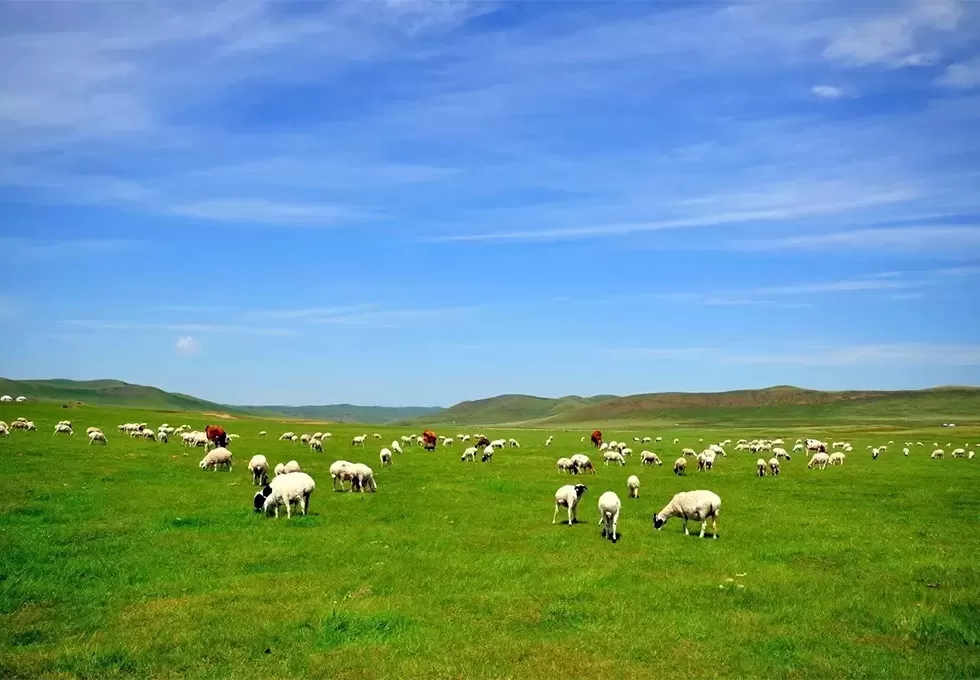Top Inner Mongolia attractions and sightseeing
Hulun Buir Grassland
The Hulun Buir Grassland is a vast area of grassland located in northeastern China, covering an area of over 100,000 square kilometers. It is one of the largest and most well-preserved grasslands in China, and is known for its stunning natural beauty and unique cultural heritage.
The grassland is located in the Hulun Buir region of Inner Mongolia, and is home to several nomadic tribes, including the Daur, Ewenki, and Mongol people. These tribes have lived on the grassland for thousands of years, and their traditional way of life has remained largely unchanged over time.
Visitors to the Hulun Buir Grassland can enjoy a range of activities, including horseback riding, hiking, and camping. They can also experience the traditional nomadic way of life by staying in a yurt, or traditional Mongolian tent, and participating in activities like milking cows, making dairy products, and riding horses.
In addition to its cultural heritage, the Hulun Buir Grassland is also known for its diverse and unique ecosystem, which includes rare and endangered species like the Manchurian crane and the Siberian tiger. It is also home to several lakes and wetlands, including the famous Hulun Lake, which is the largest lake in Inner Mongolia and a popular destination for birdwatching and boating.
The Hulun Buir Grassland offers a fascinating and immersive experience of traditional Mongolian culture and the natural beauty of northeastern China.
Xilin Gol Grassland
Xilin Gol Grassland is a vast grassland area located in the Inner Mongolia Autonomous Region. It covers an area of around 100,000 square kilometers and is home to many nomadic herders who make a living by raising livestock, primarily sheep, cattle, and horses.
The grassland is known for its natural beauty and unique cultural heritage, with many traditional Mongolian customs and practices still being observed by the local people. Visitors to Xilin Gol can experience the nomadic way of life by staying in a yurt, riding horses or camels, and participating in traditional activities such as archery and wrestling.
The grassland is also home to a diverse range of wildlife, including many rare and endangered species such as the Mongolian gazelle, the wild horse, and the red-crowned crane. Visitors to Xilin Gol can observe these animals in their natural habitats by taking a wildlife tour or visiting a nature reserve.
Xilin Gol Grassland offers visitors a unique opportunity to experience the natural beauty and cultural heritage of the Inner Mongolia Autonomous Region and is a must-see destination for anyone interested in Chinese or Mongolian culture.
Genghis Khan Mausoleum
There is a lot of mystery surrounding the burial place of Genghis Khan, the founder and emperor of the Mongol Empire. According to historical records, Genghis Khan was buried in an undisclosed location somewhere in the vicinity of his birthplace in northern Mongolia.
There have been several attempts to locate Genghis Khan's burial site over the years, but none have been successful. In 2004, a Japanese team claimed to have found the site, but their findings have been disputed by Mongolian archaeologists.
In recent years, there has been a proposal to build a mausoleum for Genghis Khan as a way to honor his legacy and attract tourists to Mongolia. However, this proposal has been controversial, with some arguing that it would be disrespectful to disturb Genghis Khan's burial site, while others believe that it would be a fitting tribute to the great leader.
At this time, there is no official Genghis Khan Mausoleum, and the location of his burial site remains a mystery.
Inner Mongolia Museum
The Inner Mongolia Museum is a museum located in Hohhot, the capital city of Inner Mongolia Autonomous Region. The museum was established in 1957 and has since become a major cultural institution in the region, with a collection of over 44,000 items.
The museum's exhibits cover a wide range of topics related to the history, culture, and natural environment of Inner Mongolia. The museum has several permanent exhibitions, including displays on the ancient history of the region, the nomadic cultures of the Mongols, and the natural resources of Inner Mongolia.
Some of the highlights of the museum's collection include artifacts from the Xiongnu and the Mongol Empire, as well as exhibits on traditional Mongolian costumes, jewelry, and handicrafts. The museum also has a large collection of dinosaur fossils, including several complete skeletons of various species.
In addition to its permanent exhibits, the Inner Mongolia Museum also hosts temporary exhibitions on a wide range of topics related to Inner Mongolia and Chinese culture. The museum is a popular destination for tourists and locals alike and is considered to be one of the best museums in China.
The Inner Mongolia Museum is a must-see destination for anyone interested in the history, culture, and natural environment of Inner Mongolia and is an excellent resource for learning about this fascinating region of China.
Zhaojun Tomb Museum
Zhaojun Tomb Museum is a historical site located in the city of Hohhot in Inner Mongolia. It is dedicated to the memory of Wang Zhaojun, a famous woman from the Han Dynasty who is said to have married a Xiongnu chieftain in order to establish peace between the Han Chinese and the Xiongnu people.
The museum is situated near the tomb of Wang Zhaojun, which is located on the banks of the Dahei River. The tomb is a circular mound, with a circumference of 33 meters and a height of 33 meters. It is surrounded by a beautiful park that features traditional Chinese architecture, statues, and gardens.
The museum itself is housed in a modern building and features a collection of artifacts related to Wang Zhaojun and the Han Dynasty. The exhibits include cultural relics, ancient documents, and works of art. Visitors can also see a replica of Wang Zhaojun's residence, which is said to have been built in the Xiongnu style.
The Zhaojun Tomb Museum is an important cultural and historical site in Inner Mongolia and attracts thousands of visitors every year. It is a fascinating destination for those interested in Chinese history and culture, as well as for anyone who appreciates beautiful architecture and natural surroundings.
Wudangzhao Monastery
Wudangzhao Monastery, also known as Five-Pagoda Temple, is a Tibetan Buddhist monastery located in Inner Mongolia. The monastery was built during the Qing Dynasty (1644-1912) and is famous for its unique architecture, which features five pagodas of different heights and shapes.
The main hall of the monastery houses a statue of Sakyamuni Buddha, which is said to be the largest wooden Buddha statue in China, standing at over 30 meters tall. The monastery also contains many other precious relics, such as ancient scriptures, Buddhist paintings, and statues of Bodhisattvas.
Wudangzhao Monastery is not only an important religious site but also a popular tourist destination, attracting visitors from all over the world who come to admire its stunning architecture and learn about Tibetan Buddhism. The surrounding natural scenery is also a highlight, with beautiful lakes and mountains in the area.
Visitors to Wudangzhao Monastery can also witness the unique local Mongolian culture, such as the traditional wrestling and horse racing competitions that take place during the annual Nadam Festival.
Wudangzhao Monastery is a fascinating destination for those interested in religion, history, and culture, as well as nature lovers and adventure seekers.
Kubuqi Desert
The Kubuqi Desert is a desert located in northern China, covering an area of over 18,000 square kilometers. It is the seventh largest desert in China, and is known for its unique landscape, diverse ecosystem, and successful ecological restoration efforts.
Despite being a desert, the Kubuqi Desert is not entirely barren. It is home to a variety of plant and animal species, including desert poplar trees, wild camels, and the rare Siberian ibex. The desert is also home to several oases, which provide vital water sources for the plants and animals that live there.
In recent years, the Kubuqi Desert has become a model for successful ecological restoration efforts in China. Since the 1980s, the local government and various organizations have worked together to implement a range of initiatives aimed at combating desertification and restoring the ecosystem. These initiatives include planting trees, building dams and reservoirs, and promoting sustainable grazing practices.
Today, the Kubuqi Desert is a thriving ecosystem that attracts tourists from around the world. Visitors can enjoy a range of activities, including camel riding, sandboarding, and hiking. They can also learn about the local culture and history by visiting nearby attractions like the Kubuqi Desert Cultural and Tourism Festival, which features traditional music, dance, and food.
The Kubuqi Desert is a fascinating destination that offers a unique glimpse into China's diverse natural and cultural heritage.
Badain Jaran Desert
The Badain Jaran Desert is a desert located in the Inner Mongolia Autonomous Region and the Gansu Province of northwestern China. It is one of the largest and highest deserts in the world, covering an area of about 49,000 square kilometers (18,900 square miles).
The desert is known for its high sand dunes, some of which can reach up to 500 meters (1,640 feet) in height. These dunes are formed by the wind, which carries sand particles from the surrounding areas and deposits them in the desert.
The Badain Jaran Desert is also home to several oases, which are areas where water is available and vegetation can grow. These oases provide a source of water and food for the people and animals living in the desert.
The desert has a unique ecosystem and is home to a variety of plants and animals, including the rare and endangered snow leopard. The area is also culturally significant, with several important historical and archaeological sites located within the desert.
Despite its natural beauty and importance, the Badain Jaran Desert is facing several environmental challenges, including desertification and sandstorms caused by human activities such as mining, overgrazing, and deforestation. Conservation efforts are being made to protect the desert and its ecosystem.
Tengger Desert
The Tengger Desert is a desert region located in northern China, spanning over 36,700 square kilometers across parts of Inner Mongolia and Ningxia provinces. It is known for its vast sand dunes, rugged terrain, and unique natural scenery.
The Tengger Desert is named after the Tengger people, who have inhabited the area for thousands of years. It is a harsh and inhospitable environment, with extreme temperatures and frequent sandstorms, but it is also a place of natural beauty and cultural significance.
One of the most popular destinations in the Tengger Desert is the Singing Sand Ravine, which is a series of sand dunes that produce a distinctive humming sound when the wind blows across them. Visitors can hike or ride camels across the sand dunes and enjoy the unique acoustic experience.
Another popular attraction is the Crescent Lake, which is a small oasis in the middle of the desert that is shaped like a crescent moon. The lake is fed by underground springs and has a history dating back over 2,000 years.
In addition to its natural beauty, the Tengger Desert is also home to several historic sites, including the Great Wall of China and the ruins of the Xixia Dynasty. Visitors can explore these ancient ruins and learn about the rich history of the region.
The Tengger Desert is a unique and fascinating destination, offering a glimpse into the natural and cultural heritage of northern China.

Useful information on Inner Mongolia
GREAT FAMILY CHINA TOUR
JULY 2024 We wanted to thank Grace at China Culture tour for organizing a great tour of China. We enjoyed our Beijing - Xian-Chengdu -Guilin -Yangshuo - Shanghai trip. Our local guides Bruce in Beijing, Susan in Xian, Jane in Chengdu, Mike in Guilin and Mary in Shanghai took care of us…read more details »
Teng Han L from SINGAPORE
Ready to Create a Unique Dream Travel?

